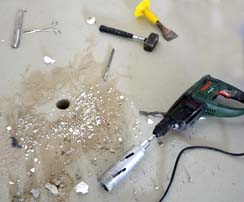
you need the right equipment
In the particular case due to insufficient sealing masonry water of a multi-family house had fallen into the basement and had soaked a storage area of eighty square meters. Under the cement floor is a layer of insulation made of polystyrene. The added expert had to decide whether the floor is completely to remove or if drying measures are sufficient. The nature and severity of the mold colonization is to be analyzed by the microbiological laboratory.
Planning and implementation of the component opening
For larger areas, the sampling points are to be determined in advance and draw in a map. It has proven to number the holes in the plan. The various sampling bags have the same number, thus allowing the unambiguous assignment and subsequent documentation. Opening device for core drilling can be carried out with a diameter of 5-8 cm. A powerful and sharp drill bits makes the job easy. Not to be forgotten is the entrainment of an industrial vacuum cleaner to suck the drilled material from the holes. Depending on the type of building construction can make use of existing openings. For example, if an existing drywall from renovation reasons already removed, then the sampler can take advantage of these openings in the floor for his removal purposes.
Initial assessment of the damage
The building biologist cuts out parts of the insulation material with a long and stable knife and takes the sample pieces with a grasping forceps through the borehole. Maybe you can already decide whether a laboratory investigation seems necessary at this point. If the insulation is extremely wet and contains visible mold, the diagnosis is likely to be unique. In less clear facts laboratory testing is recommended. In the course of the removal work, the sampler performs a wet measurement in the borehole. With probe and meter the relative humidity is determined and documented. The obligatory photo of the sampling point terminates the operation. Per well is to be expected with a time requirement of 20 to 30 minutes.
Which remedial action is appropriate?
The degree of restoration depends on the amount of moisture and mold exposure:
a) If only a low moisture and no or only a moderate mold growth (<20 CFU) exists, a building drying without screed expansion may be sufficient. The building drying needs short term, i.e. be performed within 3 weeks after the incident. Additionally, it should be technically feasible and economically viable.
b) building drying and disinfection are possible at an average mold exposure from 50 to 200 CFU. The disinfectant must be technically feasible and carried out by an approved contractor.
c) an expansion is unavoidable at high moisture and mold colonization of >200 CFU culture medium.
The expert comes to a high degree of responsibility. The determination of the number and location of sampling are crucial for the analysis. An incorrect assessment can lead to high costs for the client or in recourse to the appraiser.
Mid-2013, the Federal Environment Agency (UBA), a “guide to action for the evaluation of moisture damage in floors,” released as a draft for public discussion (see link below):
https://www.umweltbundesamt.de/www.umweltbundesamt.de/schimmelleitfaden
